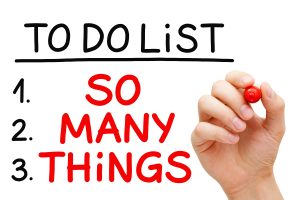Your work environment (regardless of whether you are at work or home) is filled with “noise” that can distract you from getting things done. There are tons of obstacles in the office that are distracting, like your coworkers. I find it very challenging to focus with people are laughing, talking loud, having conference calls on speaker, or interrupting you every chance they get.
Working from home can be equally as challenging. At my house my son is home every day. I’m not caring for him, my sister-in-law does. However, I can hear him cry, run, laugh, talk, and play. Before he was born, I was distracted with all the other things that I could be doing at home like doing laundry or watering the grass or watching tv. The point is distractions are everywhere.

For these reasons, it is important to take a proactive approach and arrange your workspace in a way that helps you clear your mind so that you can produce your best work or at least get things done.
Here are eight strategies to get things done:
#1: Empty your Mind
Get all the things you have to do out of your head and on paper, in an email, or on a document. There are many ways to capture all the things you have to do. Once they are out of your head and on paper, then you can prioritize them and strategize how you will get them done.
When I get overwhelmed with a lot of things to do. It’s because I have not written down the things I need to do. Once I write down my list of things to do, I feel like a monkey has been lifted from my back.
#2: Shut down your email
Email is so distracting when you need to get things done. I think the best way to manage email when you have a lot to do is to schedule time to check your email. Email notifications are triggers to get you to stop what you’re doing. Once this happens, you have to come back to where you left off, and that’s not always seamless and easy.
For instance, Kaye schedules “inbox time” for the end of each workday, long after she’s completed her high-energy-level tasks. Furthermore, she has disabled all email notifications on both his email and cellphone. That way, she’s only able to look at email when she’s ready to take action on each message.
I’m not sure I’d wait until the end of the day, but you have to find what works for you and your work.
#3: Manage noise levels
Each person is different when it comes to the noise they can tolerate. Some people need absolute silence, while others need white noise to block out distracting sounds in their environment. It all depends on what works best for you.
If you like to listen to music, experiment with different styles until you find one that helps you be more productive with each type of task. Kaye likes listening to ocean waves while writing, but she needs upbeat music when she’s working on tasks that she prefers not to do.
#4: Manage meetings
Sometimes meetings are unavoidable. Depending on your work situation, you may not have control over the meetings you attend, but if you do, keep the following tips in mind:
- If you can conduct meetings standing up. Have a chair or two available if someone really needs to sit.
- Have an agenda for the meeting. Send it to attendees ahead of time so they have an opportunity to propose important items before the meeting starts. This keeps the point of the meeting clear and helps prevent you from falling down a rabbit hole of tangential topics.
- Have a time limit on each topic. People will learn to get the important things out fast.
- Only invite people to the meeting that need to be there. However, make sure that you have the right people in the room. This requires planning and forethought depending on what the meeting is trying to accomplish. For example, you may not realize that you need to have a decision maker from finance when you are brainstorming ways to get a project back on track. If you’re project is behind you might want to have that finance person at the meeting just in case.
- Only schedule the meeting for the amount of time you think you need. In some work environments, meetings are typically 1-hour long regardless. Use your agenda to better plan the duration of the meeting.
Most meetings are an incredible waste of time and human resources. I suggest that you either avoid meetings when you can or look for ways to streamline the entire process.
#5: Avoid multitasking
I love multitasking, but it doesn’t work. I love it because it makes me feel like I’m accomplishing a lot at one time. However, countless studies have proven that people’s productivity diminishes when they engaged in more than one task.
The problem I’ve had with multitasking is that it is a breeding ground for errors. In fact, multitasking reduces creativity, and makes it harder to remember important details. Work on one activity at a time and nothing else.
#6: Have a strategy for interruptions
You don’t always have as much control over your day as you’d like. What tends to happen is interruptions happen making it impossible to stay productive because you constantly have to deal with something.
We all experience interruptions, but what separates the successful people from everyone else is knowing how to handle them when they occur.
Here are a few strategies to do this:
- Accept that there will be interruptions. It’s uncontrollable. What you can control is your response to these random events.
- Start work earlier than everyone else. I don’t know about you but around 9 or 10 am is when meetings are scheduled and bulk of emails start and the phones start ringing. Maybe a proactive strategy might be to start work a few hours earlier. You could also try staying late too.
- Invest in some noise-canceling headphones to reduce the annoying loud talking, laughing, and other noise that can distract you.
- Stick to your schedule as much as you can. In the beginning of your day, plan your day, then try to stick to it.
- Have a plan for when you get interrupted. That way you can quickly deal with the interruption and get back to what you were doing.
#7: Say no
Learning to say no is tricky. A lot of people want to be helpful and they will say yes to things when they should be saying no to.
A great way to say no is to communicate what you are working on. Even if it is your manager or a senior leader. If someone asks you to do something, communicate all that you are working on. If this is your boss, let them prioritize how you spend your time, rather than accepting tons of additional work.
For example, you can say,
“Yes, I’d be happy to do write the report, but that will put me behind on the proposal that’s due on Friday.
Would you prefer that I do report first, or would it be better for me to focus on proposal instead?”
Just remember this: Whenever you say “yes” to a request, you say “no” to something else in your life.
Keep in mind that saying no isn’t rude, and there are many ways to say no without using the word “no.” For instance, you can say something like, “Thanks so much for considering me for this opportunity, but I don’t have the bandwidth to do it justice right now.
#8 Delegate
If you can have someone or something else complete tasks for you, do it. Of course you need to know if it makes senses to outsource tasks. If you are a supervisor or a team lead, assign work to other people that can get things done. Sometimes it takes longer to explain how to do an assignment than it does to actually do the work. You have to think about if it’s worth it or not. If the work in reoccurring, then it would be worth taking time to explain it. It also depends on how much time you have to meet your deadlines. In the beginning it takes people time to learn how to do things, but once they get up to speed, they should be able to take on projects with much less guidance.
You don’t have to be in a position of authority. Delegations could be simply asking someone for a favor. For example, if you are swamped at work, you could ask your coworker to pick up lunch for you while they’re out. Of course, it generally is not burdensome if you are giving them money, you’re willing to do the same for them, and you’re not always asking them to go out of their way.
Being productive isn’t about getting more time each day―everybody has the same 24 hours each day. Instead, you should strive to be productive to spend as much time as possible doing what you love and spending time with the people who truly matter.
Regardless of your situation and the demands on your time, with a little bit of creativity and careful planning, you can have time for the things that matter most. Use these strategies and start seeing improvements in the way you use your time.
What are the activities you engage in that eat up your time?
